What is PWM display flicker, how to deal with it
If you get headaches or your eyes hurt after looking at your phone, PWM is probably at fault.
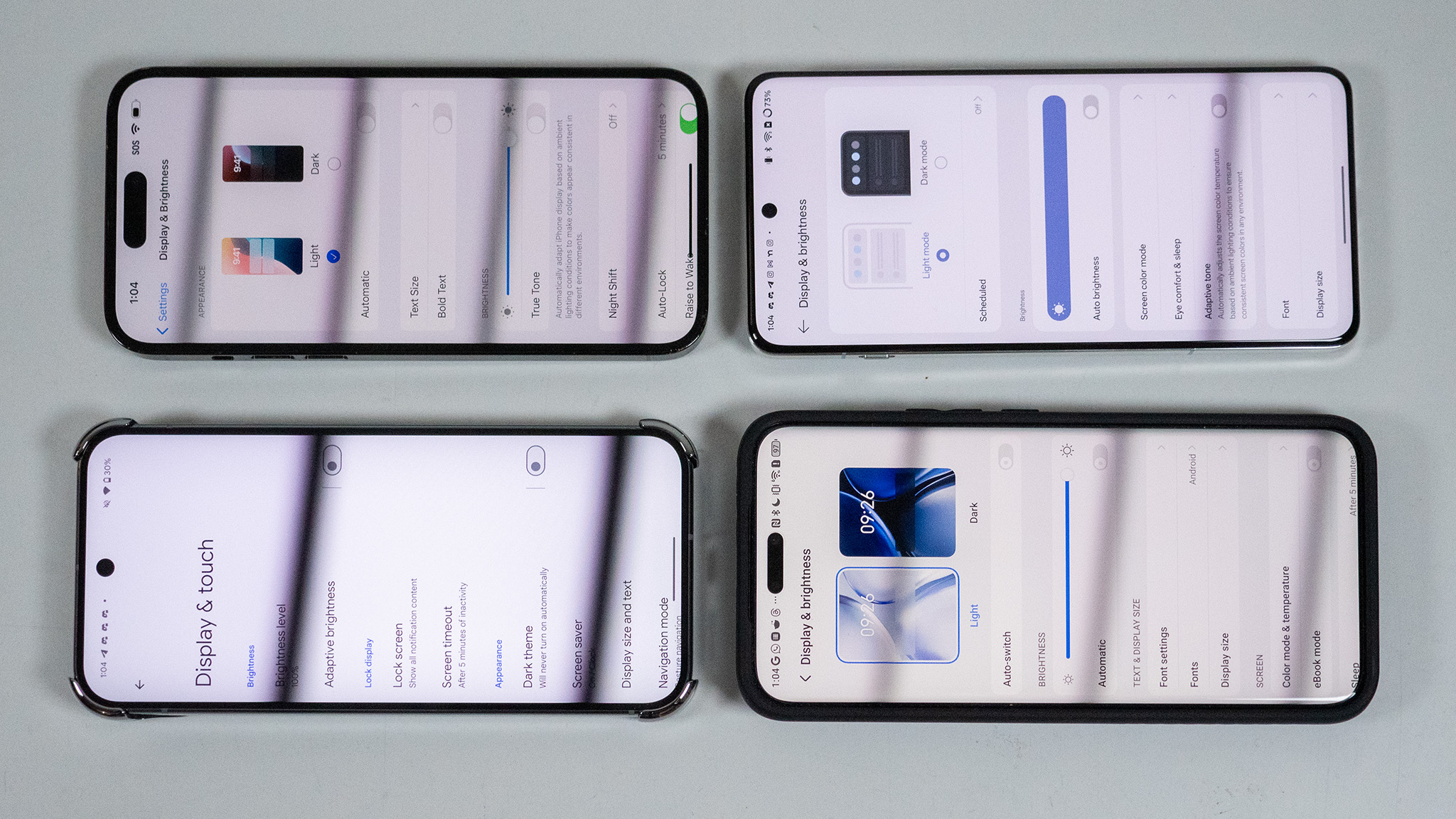
Have you ever looked at your phone and gotten a headache? Sometimes, it just means you've been on it too long and need to take a break. For some folks like me, it's the display itself that's causing the issue.
PWM, or pulse width modulation, is a dimming method some displays use in place of traditional voltage adjustment. Instead of actually getting dimmer, displays that use PWM rapidly turn on and off to fool your eyes into appearing brighter or dimmer. PWM is used on displays of all kinds, from smartphones to TVs, tablets, smartwatches, and even smart glasses. Your LED lightbulbs may also use PWM to dim.
Many of the best phones — including the Apple iPhone, Google Pixel, and Samsung Galaxy series — use PWM all the time and are causing real pain for users. Thankfully, many companies have heard the call for improvement and have moved away from PWM dimming, but a lot of progress still needs to be made from the biggest brands.
Research has proven that PWM dimming causes health problems in many people, although it's not yet known exactly how many people suffer from the condition because most people have never heard of PWM. My goal is to educate as many people as possible and help remove as many of these awful, flickering nuisances in the world as possible. Knowledge is power, and people must know and understand the hidden dangers all around them.
Read on to learn more about why your phone, TV, or lights may be causing your headaches.
What is PWM dimming?
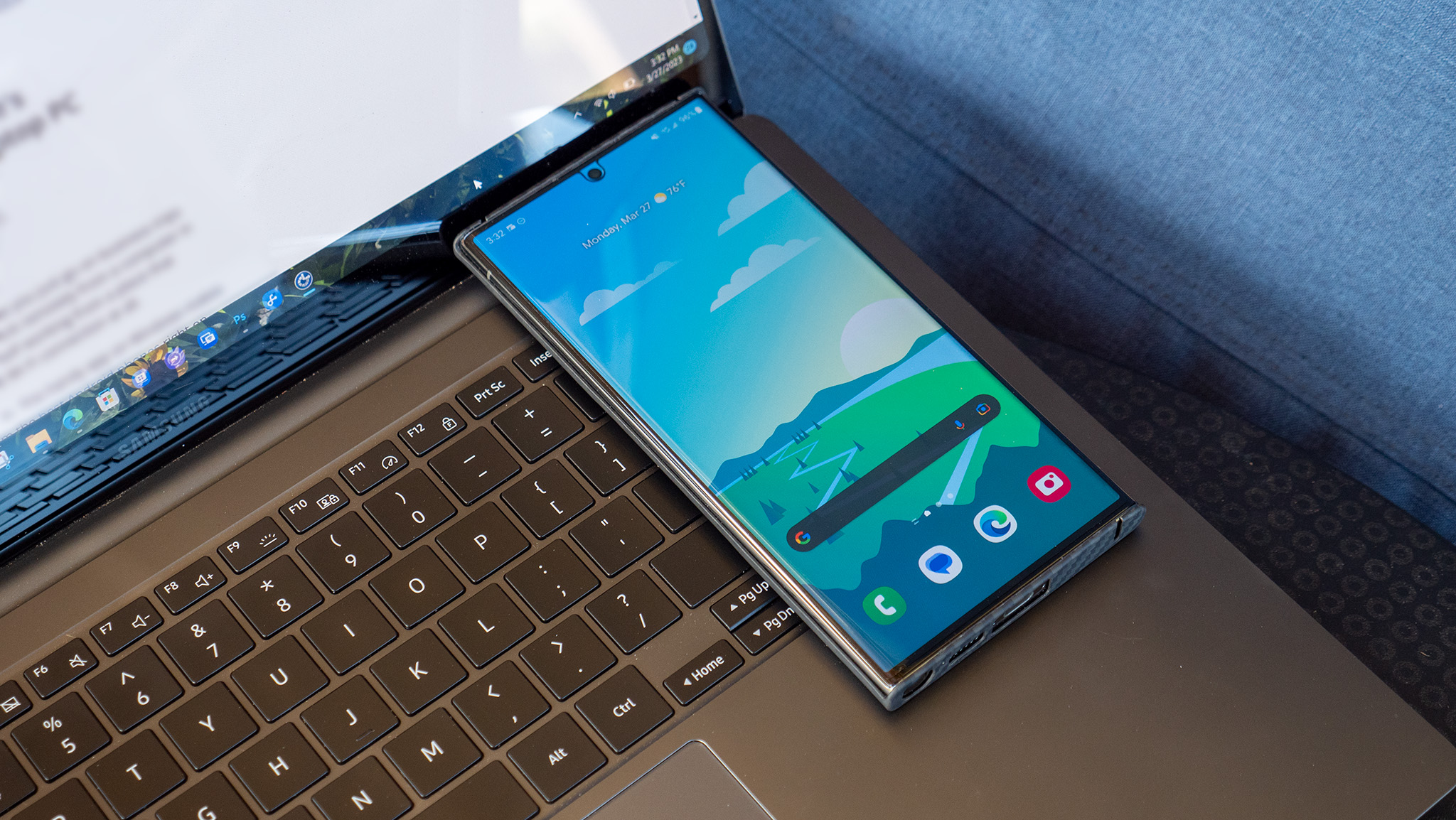
PWM dimming works by flashing the screen on and off very quickly. Think of it a bit like watching a movie, which is comprised of pictures being shown back-to-back many times per second.
Your brain interprets this rapid progression of images as movement in a movie, but in the case of PWM-dimmed phones, your eyes see a brighter or dimmer image depending on how often your phone's display is on or off per second.
Be an expert in 5 minutes
Get the latest news from Android Central, your trusted companion in the world of Android
PWM dimming works by flashing the screen on and off very quickly, which tricks your eyes into seeing a "brighter" or "dimmer" screen.
The reason this is different from a movie is that movie frames are evenly lit in progression from one to the next. PWM flashing, however, alternates between 100% brightness and 0% brightness, providing a harsh, stark contrast to your eyes and brain.
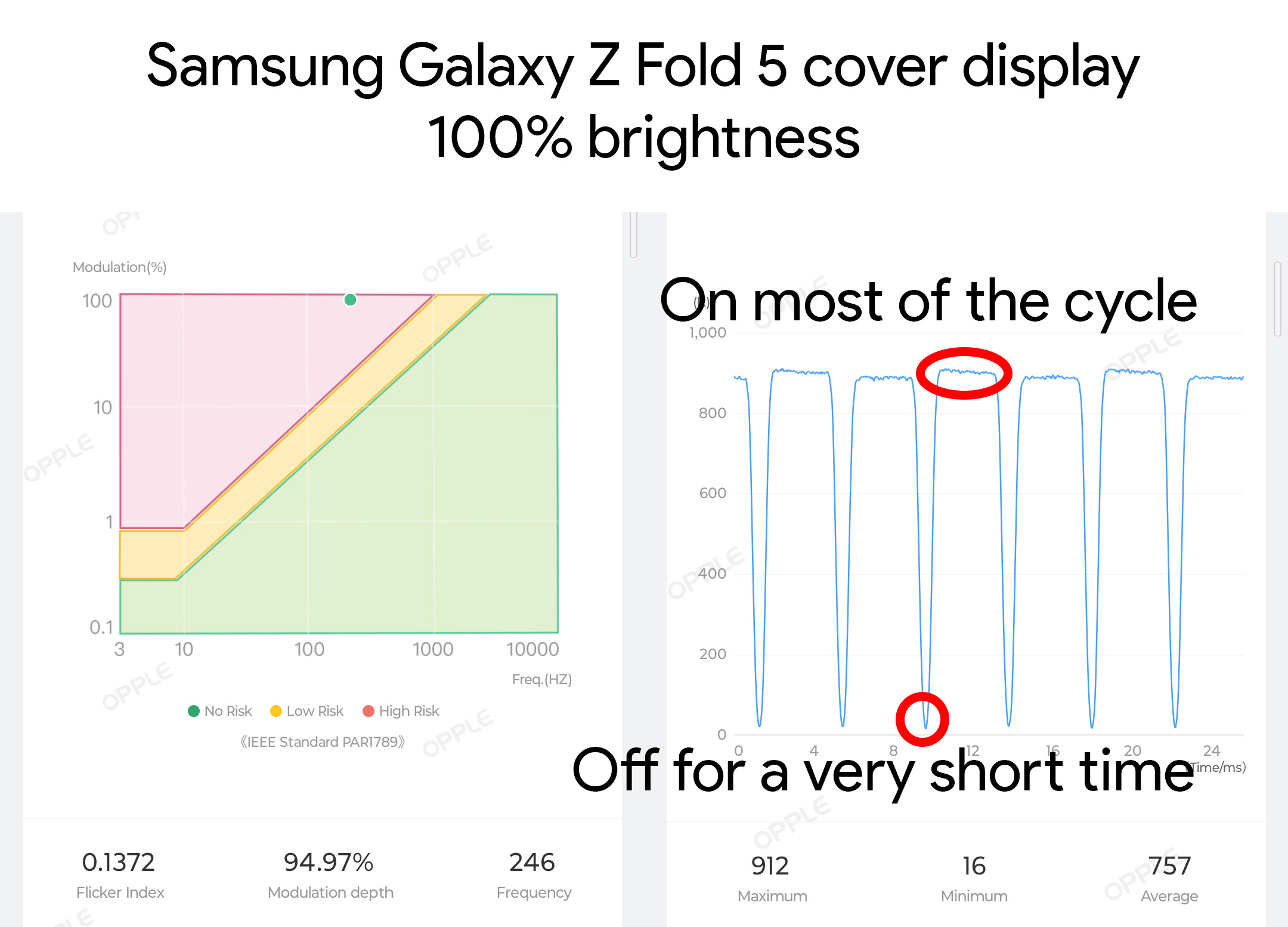
Graphs like the one above — which show the Samsung Galaxy Z Fold 5's outer display at 100% brightness — show the pattern of on/off cycles that your eyes don't see but your brain perceives. The difference between the highest and lowest points is the modulation, which is defined as the percentage difference between the brightest and dimmest values.
In layman's terms, that simply means how bright the display gets for a split second before turning off momentarily, then repeating the cycle over and over again several hundred times per second.
Imagine a bright light flashing constantly at you in a dark room and you'll quickly understand why PWM is problematic.
As you lower the brightness slider, the screen isn't actually getting dimmer. Instead, what's happening is that the screen stays off for longer periods of time as it continues to flash on and off hundreds of times per second. Imagine a bright light flashing at you constantly in a dark room, and you'll quickly understand why this is problematic.
That difference between the screen being on for a split second followed by staying off for a split second is incredibly jarring to the human brain. While it doesn't affect some people as negatively as others, it's still exposing you to a strobing light all throughout the day. We know from research that this kind of exposure is bad for your health.
Why do phones use PWM dimming?
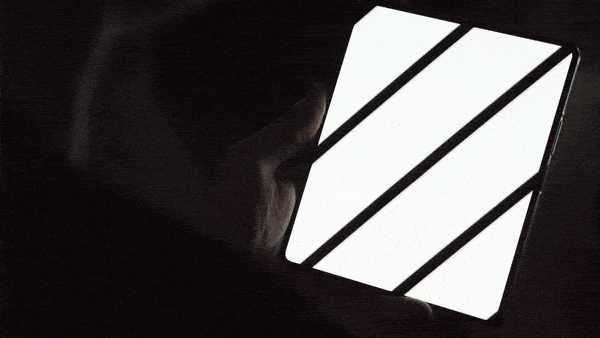
Smartphone displays generally use two main methods to control brightness. DC dimming is the traditional light-dimming method. This regulates the amount of voltage sent to an LED panel. The more power you supply, the brighter the LED gets. Reduce that power, and the LED gets dimmer.
But, as smartphones began to switch to OLED displays, manufacturers started using PWM to manage brightness instead of DC dimming. This sounds ridiculous — and, in many cases, it truly is — but there is a valid reason for all of it.
First, let's quickly examine the difference between LCD panels and OLED displays. An LCD panel features a fully white backlight behind colored pixels. These colored pixels act like a filter for the light but have nothing to do with the brightness or intensity of the light itself. They are completely separate pieces of the display puzzle.
This backlight can be dimmed separately from the colored pixels by reducing power to the white LED backlight, thus, dimming that white light like a light bulb.
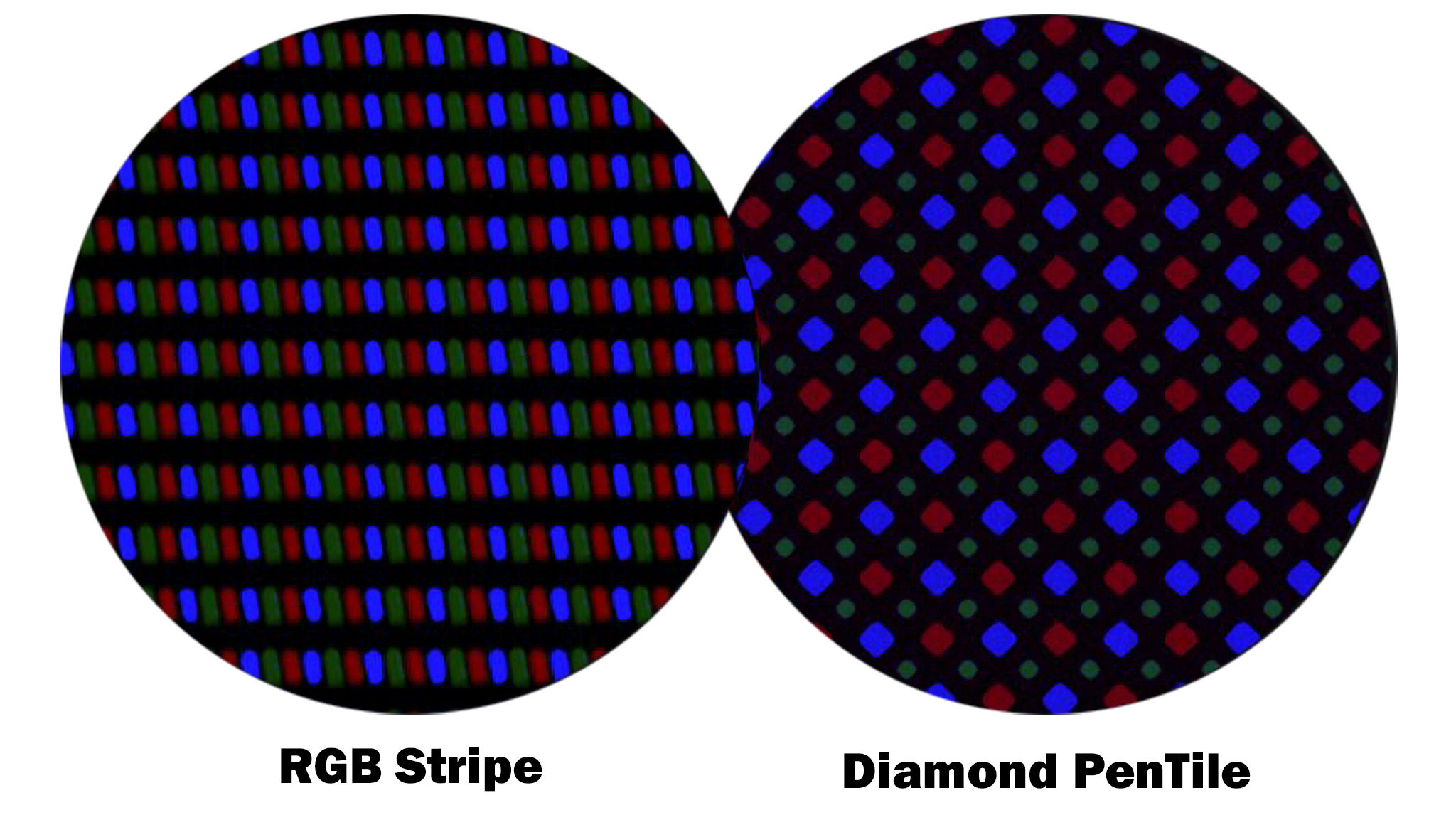
Display engineers solved a technology problem with PWM but forgot to include the human element in the equation.
OLED displays use individually-lit pixels, typically made up of red, green, and blue sub-pixels. Each of these sub-pixels gives off its own light, so the intensity of the brightness is directly tied to the color.
As OLED pixels are dimmed, the accuracy and intensity of the color also dim. A few years ago, OnePlus experimented with a fully DC-dimmed OLED panel on the OnePlus 6 and 6T. However, when the brightness dropped below 30% or so, greys would become green, and other colors just wouldn't look right.
For this reason, manufacturers typically use PWM dimming at low brightness levels. When a display uses PWM dimming, it gives 100% power to each pixel, ensuring that color accuracy and intensity stay the same no matter the brightness level.
It's a brilliant solution to a technological problem, but it forgets to take two major things into account: human eyes and brains.
Some manufacturers are finally realizing that strobing a light at users all day long isn't healthy and are now using DC Dimming at medium-high brightness levels.
Most manufacturers in 2025 — Motorola, OnePlus, Vivo, Honor, Xiaomi, and Nothing, to name a few — have begun to offer alternative solutions that are far easier on human eyes and brains, all while retaining the visual quality we expect from OLED displays.
All OLED-equipped Motorola phones offer the ability to disable PWM dimming entirely. Motorola launched its anti-flicker function with the Motorola Edge Plus (2023) and it was met with big acclaim in the PWM-sensitive community.
Phones like the OnePlus 13, Honor Magic 7 Pro, Nothing Phone (2), and the Xiaomi 15 series use a hybrid dimming model. At medium to high brightness, these phones use DC dimming and adjust the voltage to the screen, which is the preferred dimming method for any kind of light source (including screens). At low brightness — usually under 30% brightness — these phones switch to PWM dimming but use a high refresh rate, typically above 1920Hz.
Other phones, like the Vivo X200 series, use PWM at all brightness levels but use a very high refresh rate, typically above 2160Hz. For comparison, Google Pixel phones use 240Hz PWM dimming while iPhones and Galaxy S phones typically use 480Hz.
Waveforms and the brain
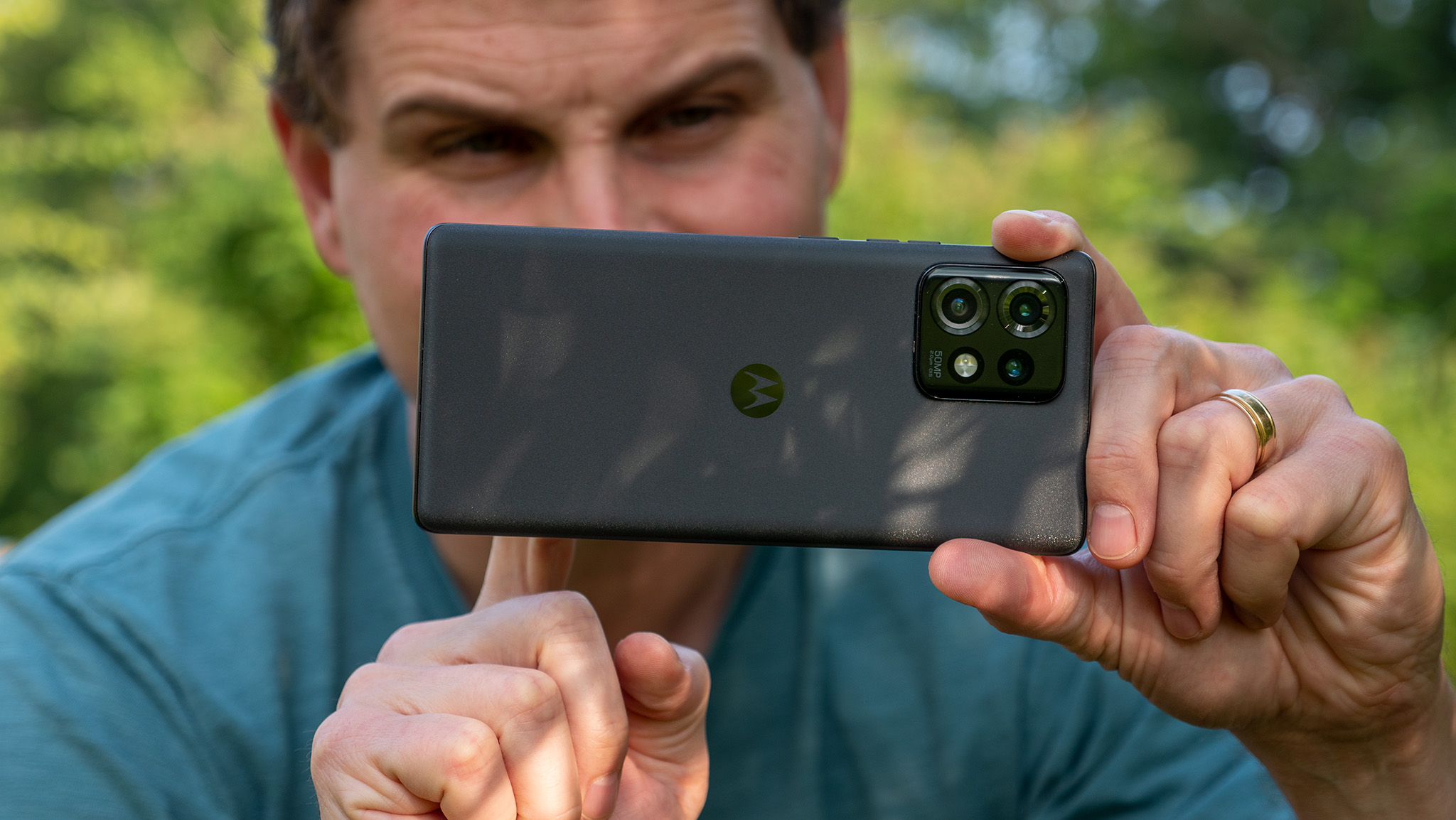
Dialing down further into the causes of PWM/flicker-sensitivity, a few factors seem to affect most people in this category. When using a tool to measure flicker parameters, the end result comes out looking like a waveform on an oscilloscope. If I've already lost you, hold tight. I promise I'll keep this simple.
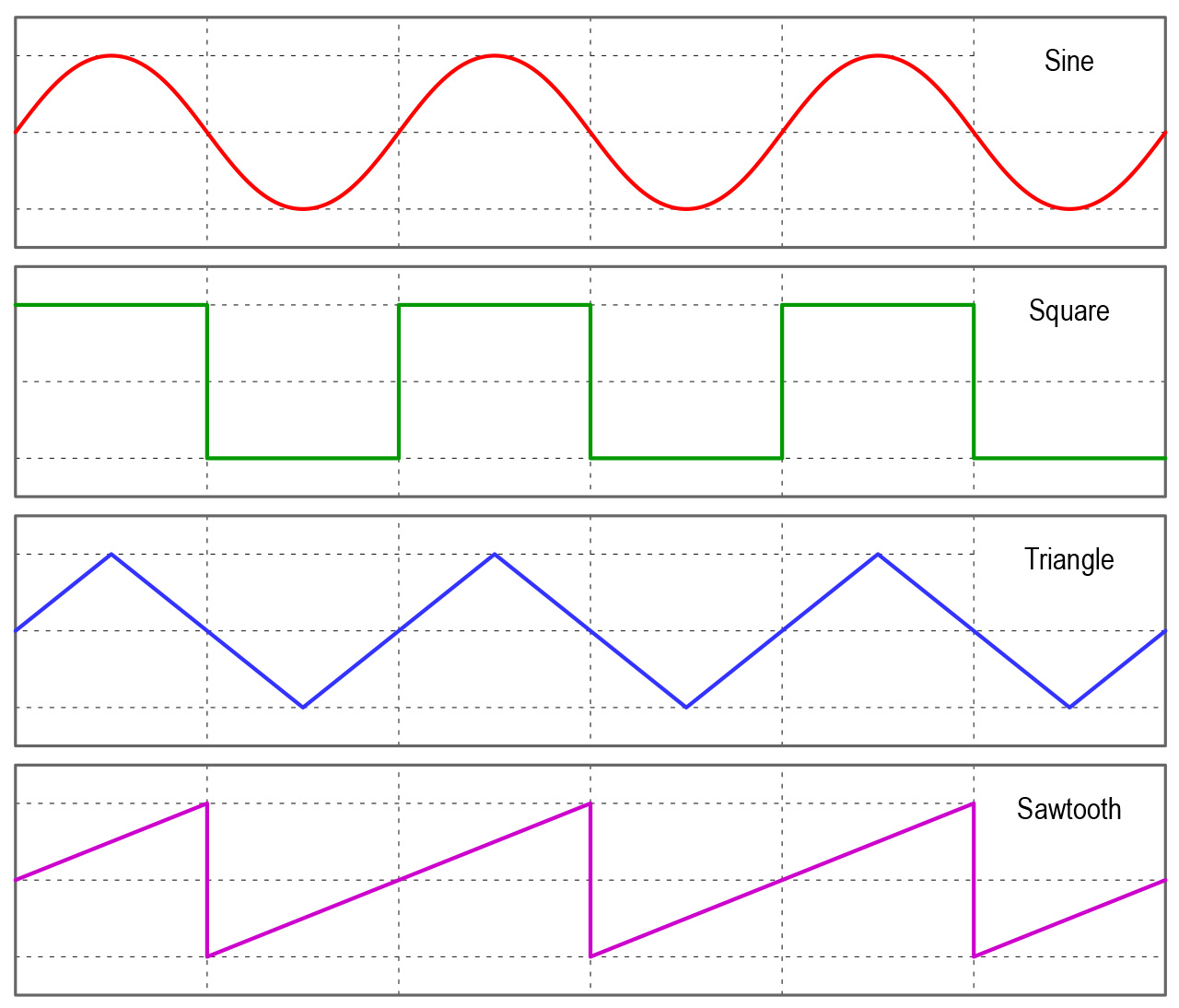
The most comfortable pattern is, effectively, none at all. The straighter the line, the better the light will be for your brain. Many LCD screens and E-Ink screens have a completely (or nearly completely) flat line for a graph. These light sources are constant and don't flicker or adjust in a perceivable way.
The second most comfortable wave pattern is the sine wave. Incandescent bulbs sport a sine wave because the brightness of the filament is directly related to the oscillating nature of the AC, or Alternating Current, power that comes out of a wall outlet. Displays that utilize PWM dimming can be comfortable if they adhere to the sine wave pattern, but this comes with caveats.
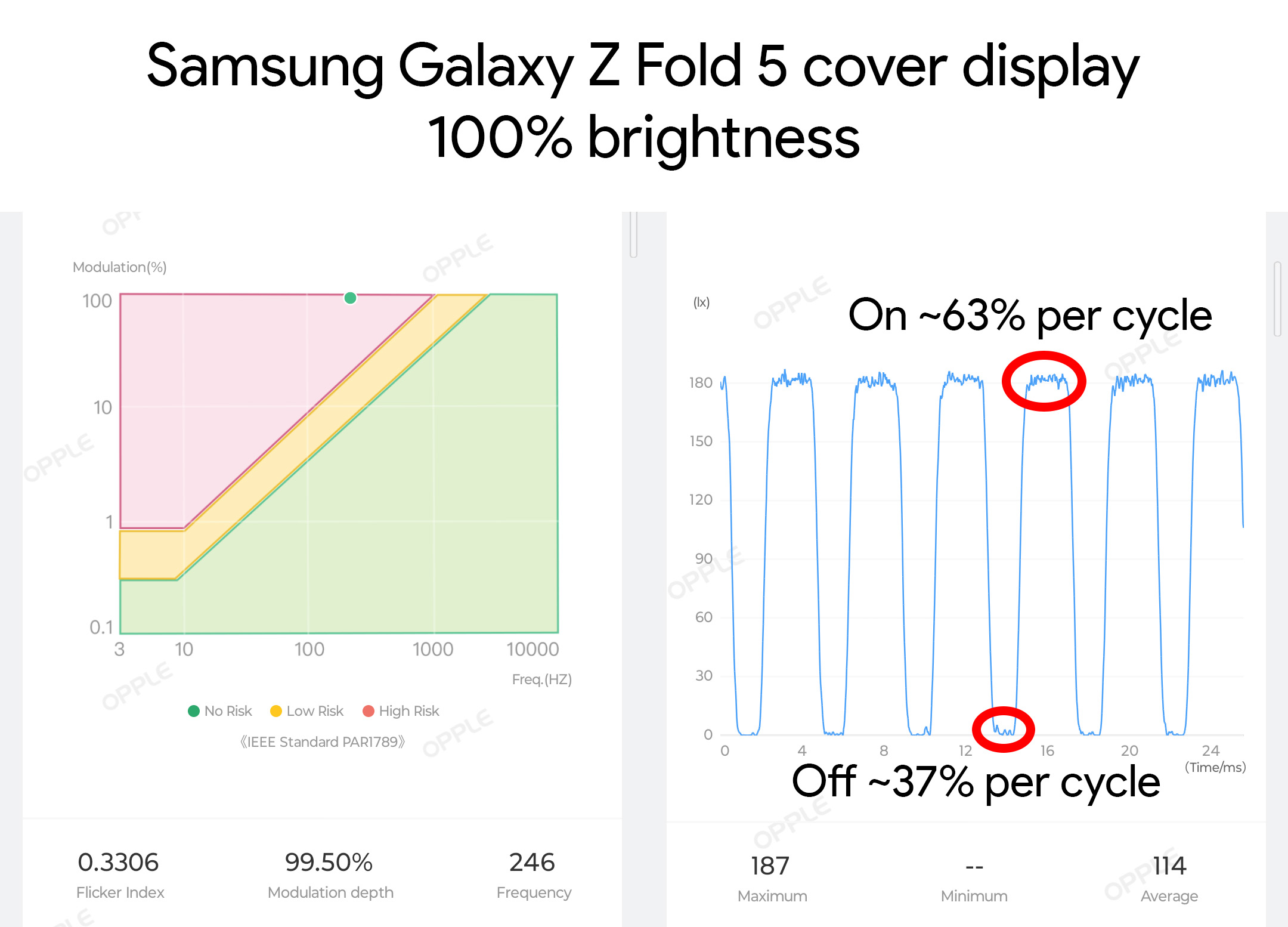
Displays that come across using other waveform patterns above tend to flicker at varying or harsher rates. I've found this to be extremely uncomfortable in most cases. The Galaxy Z Fold 5 example above shows a square waveform which is a very harsh on/off pattern.
Conversely, if you look at the graphs below, you'll see two examples of far more eye-friendly displays. The TCL Tab10 NXTPAPER 5G has a nearly completely straight line, while the Honor 200 has very shallow dips in brightness at the beginning of each refresh cycle.
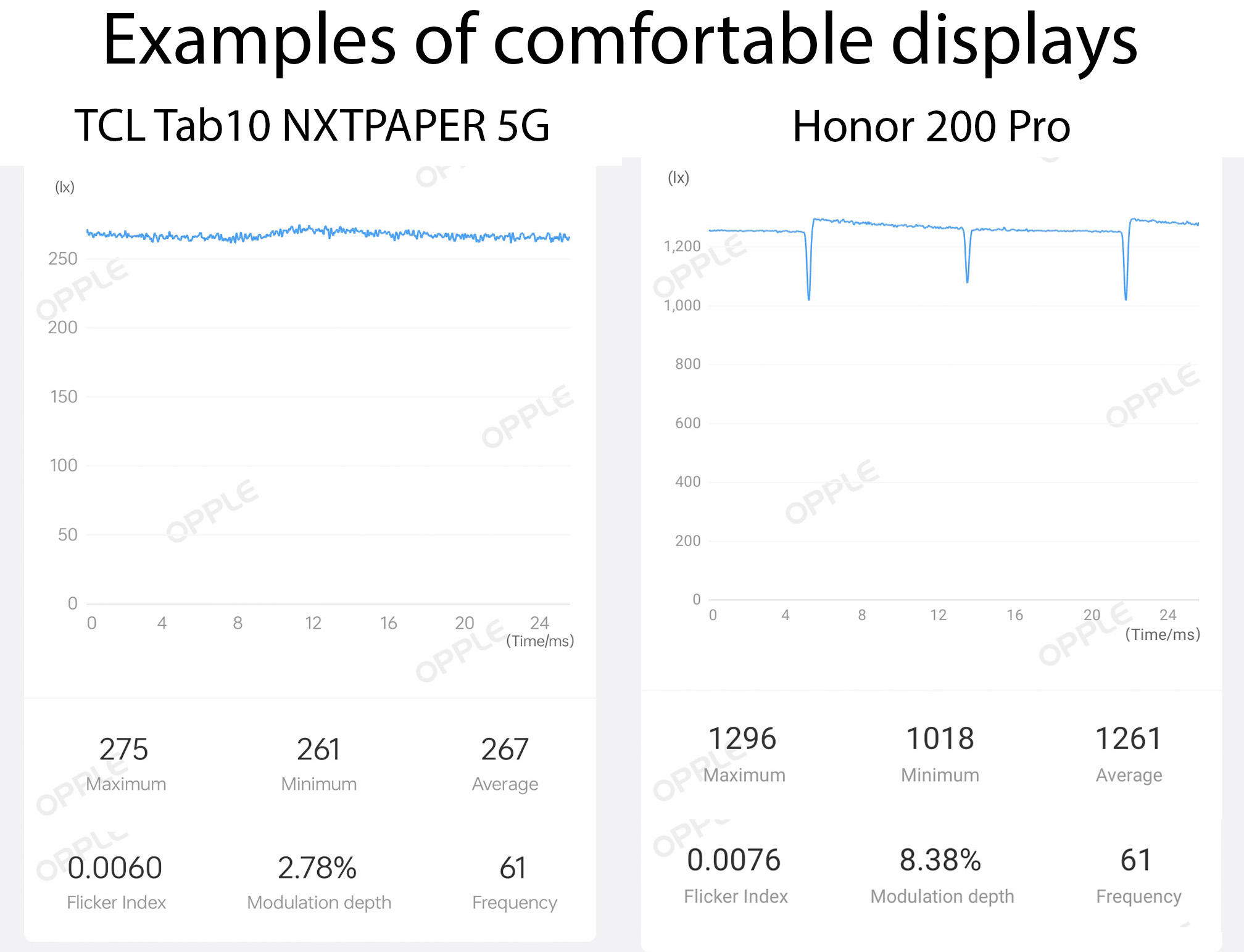
Based on research, the only way for PWM to be comfortable is if it's in the thousands of hertz, not hundreds.
Lastly, I'll look at the PWM rate, which means how fast the display can flicker per second. Most Samsung Galaxy and Google Pixel phones flicker at a very low rate of 240Hz, or 240 times per second.
Newer Galaxy phones and all Apple iPhones use a frequency of 480Hz. Higher numbers can lead to greater comfort, even when using PWM to "dim" a display, but none of these phones go far enough. In fact, research shows that the 240-960Hz range is the most dangerous for human health, meaning Apple, Samsung, and Google have a lot of work to do.
How to deal with PWM sensitivity
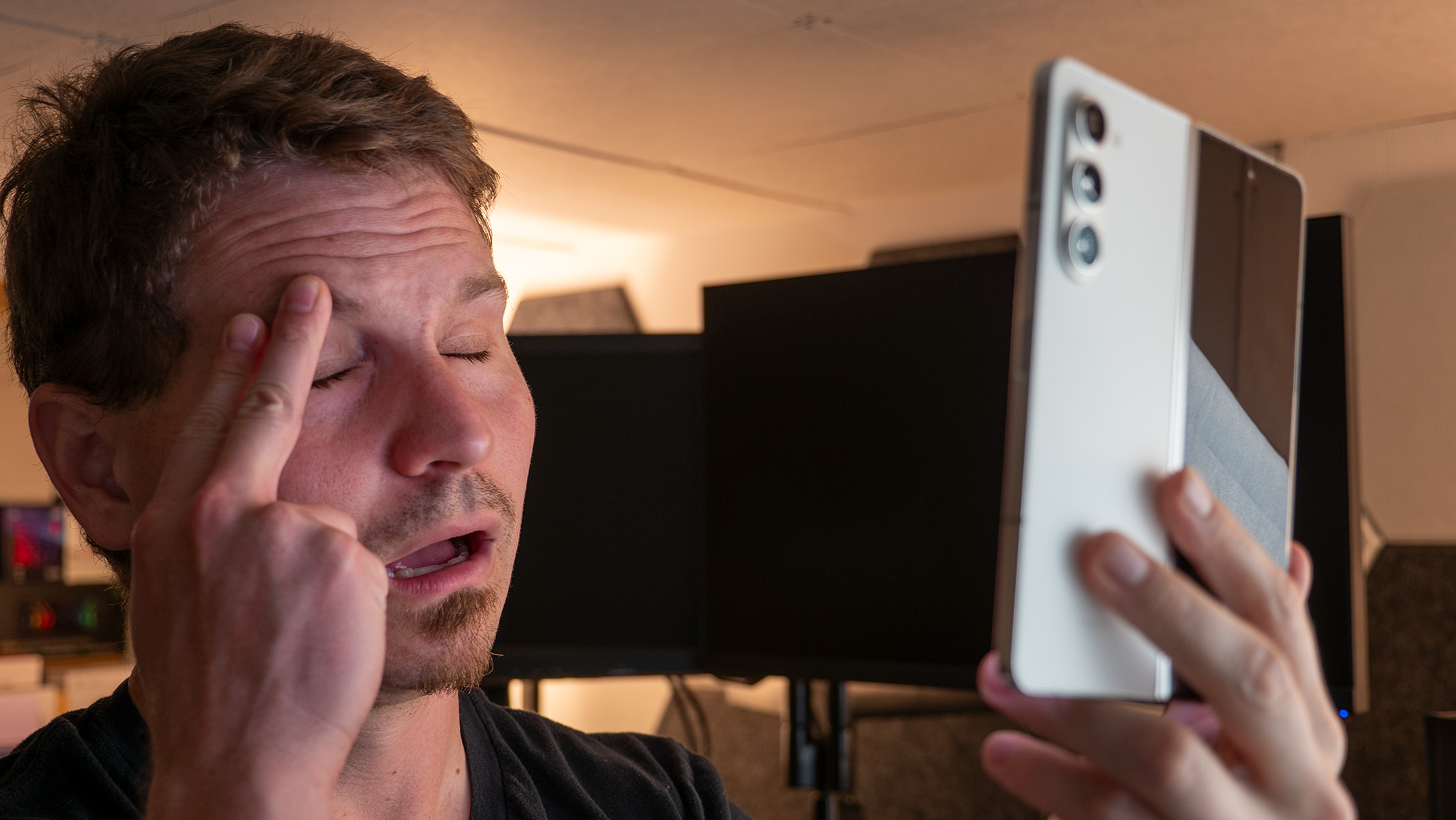
Being sensitive to flickering lights or displays is simply no fun. Flickering light sources can cause eye straight, headaches, dizziness, a sense of vertigo, nausea, and plenty of uncomfortable or painful sensations. Thankfully, there are ways of managing these symptoms and things you can do to help prevent them in the first place.
No matter which phone you use, being PWM or flicker-sensitive means you should take some precautions to ensure you're not exposing yourself to too much flicker. Here are some tips and tricks to help make your phone easier on the eyes.
See an optometrist
First and foremost, if you're experiencing any of the symptoms described above while looking at your phone, go see an optometrist. I personally dealt with increased sensitivity and harsher symptoms over a period of a few months before I went to an optometrist, and I couldn't have been happier with my experience.
In my case, one of my eyes had astigmatism, and my optometrist was able to give me a new reading glasses prescription to correct that astigmatism. Many people who are sensitive to flickering light and flickering smartphone displays also have astigmatism, and correcting this problem could very well solve your sensitivity issue.
In my case, I'm able to use flickering phones so long as I wear my glasses, but even this is within a limit. I don't dare use any of these flickering phones below 50% brightness or in a dark room, and I generally cannot use them when I'm not wearing my glasses.
That means some phones are simply off-limits for daily use. I can't use these types of phones to navigate while driving, for instance, since my glasses are for reading only.
Don't use automatic brightness
Automatic brightness is a great concept when a phone uses DC dimming. For phones that use PWM to dim, automatic brightness is a quick way to get a headache. Instead, manage the brightness yourself and keep it at a level that you feel is manageable and doesn't give you eye strain.
That's because PWM-dimmed phones flicker more harshly at lower brightness levels, increasing the potential for PWM sickness. Some people think that reducing the brightness on these phones would help, but remember that phones that use PWM don't actually dim — they just flicker more.
I recommend using this practice in conjunction with the next tip.
Try a screen-dimming app
Don't use your phone's brightness slider to adjust brightness. Instead, I would recommend keeping the system brightness slider at 100% to keep screen modulation as low as possible. Then, use a screen-dimming app to control brightness since it works differently.
First off, I would never recommend dimming most smartphone displays under 50% if you're sensitive to light flicker. Even most of the most eye-friendly smartphone displays start to do funny things below 50% in order to maintain high image quality at low brightness values.
I've tried a lot of screen-dimming apps, but this screen and notification-dimming app is my all-time favorite. Not only does it feature a handy control panel that stays in your notification shade at all times and has a quick toggle button, but it actually dims notifications and system-level dialogs.
Many screen dimming apps will only dim apps by adding a grey overlay on top of the screen which isn't allowed to be displayed over system-level UI elements. Worse yet, most of these apps don't let you click "secure" buttons which means you regularly have to disable them just to do normal things on your phone.
The app I recommended has none of these problems and works as you would expect it to.
Don't use your phone in a dark room
Using your phone in a dark room is one of the quickest ways to develop those awful feelings of PWM sickness. It doesn't matter what brightness level your device is at — especially if you're using a phone that uses PWM to dim the display. Sitting in a dark room looking at a bright phone just isn't good for your eyes.
Instead, try to keep the ambient lighting in the room at about the same brightness level as your phone. Automatic brightness would do this already, but for us PWM-sensitive folks, automatic brightness isn't usually an option since phones tend to flicker more at darker brightness levels.
Additionally, I would recommend using a flicker meter to test the lightbulbs in your home to ensure they don't flicker. If you don't have a specialized light meter, this flicker meter app is free and can help you detect light bulb flicker.
I wouldn't use its measurements as an exact science, though. Rather, just use it to help detect bulbs that can be replaced with flicker-free versions like these Sylvania flicker-free LED bulbs. I use those in my home and love them.
Replace your lights
As I started checking around my house for light sources that used PWM, I found that about half the lights in my home were a flickering mess. Many smart lightbulbs, including popular brands like LIFX and Nanoleaf, use PWM to adjust brightness. Some brands, like Philips HUE, offer flicker-free solutions but may cost a bit more.
I have removed all of the smart lights in my home except for these Philips HUE bulbs. I would also recommend getting smart lights that are only one color. While changing the color on a smart light looks cool, the LEDs in the bulb don't actually change color.
Instead, a combination of red, green, and blue LEDs quickly flicker on and off to create the perception of a color that doesn't exist. This method is called color dithering and is also present on many different kinds of displays. I'm not personally affected by color dithering but know people who are.
Don't use dark theme on some phones
It might sound weird, but OLED displays using PWM modulate more when displaying darker colors. That's because color and light intensity are linked together in a single LED diode, as I explained in the section way above. Phones using OLED displays that use DC Dimming are just fine to use dark mode of any shade, as evidenced by the images below.
Most dark theme apps don't use a black background, which would actually turn individual OLED pixels completely off. Instead, many developers and smartphone companies use a dark grey background which is more harmful to your eyes than a completely black or completely white background.
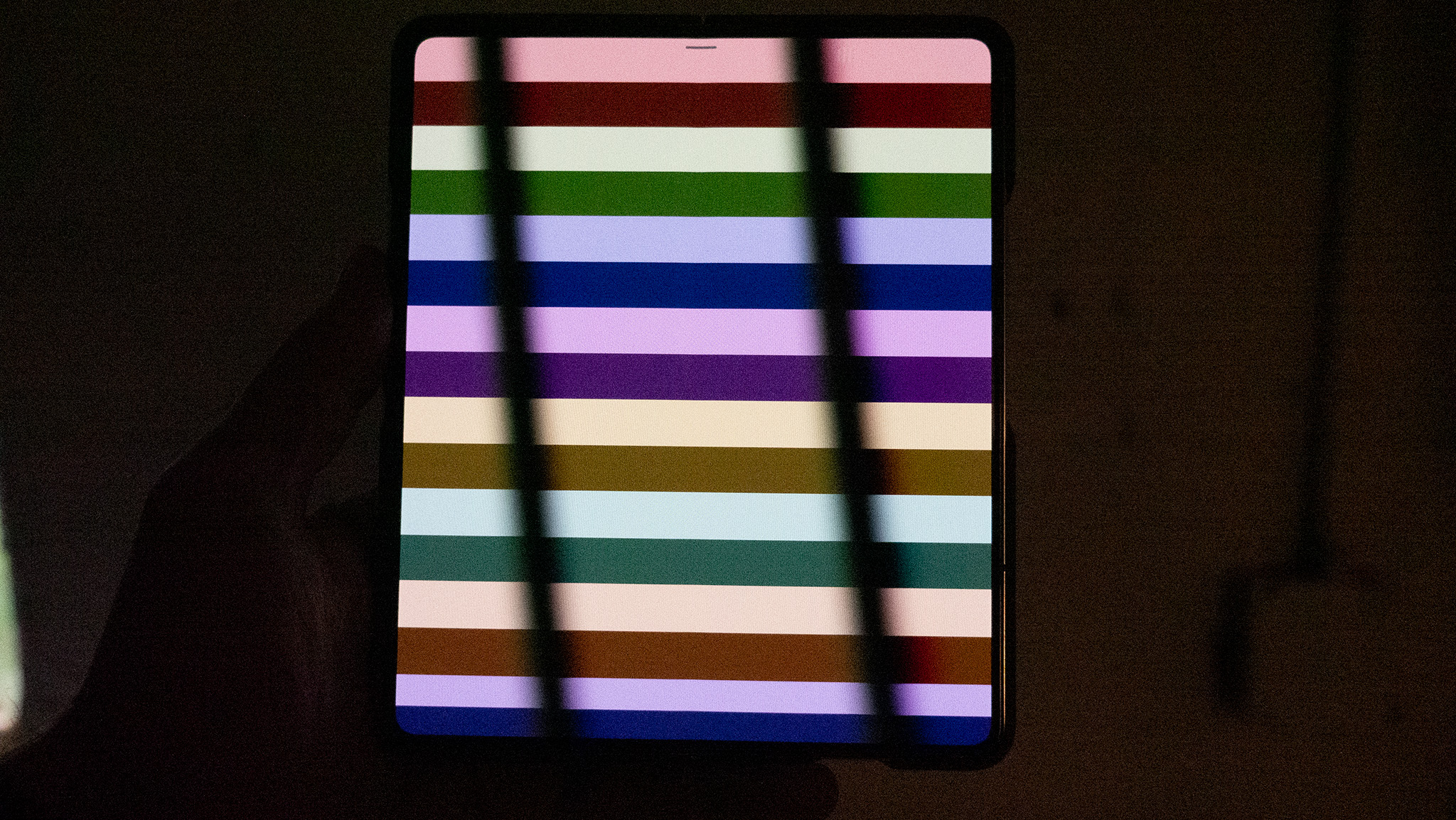
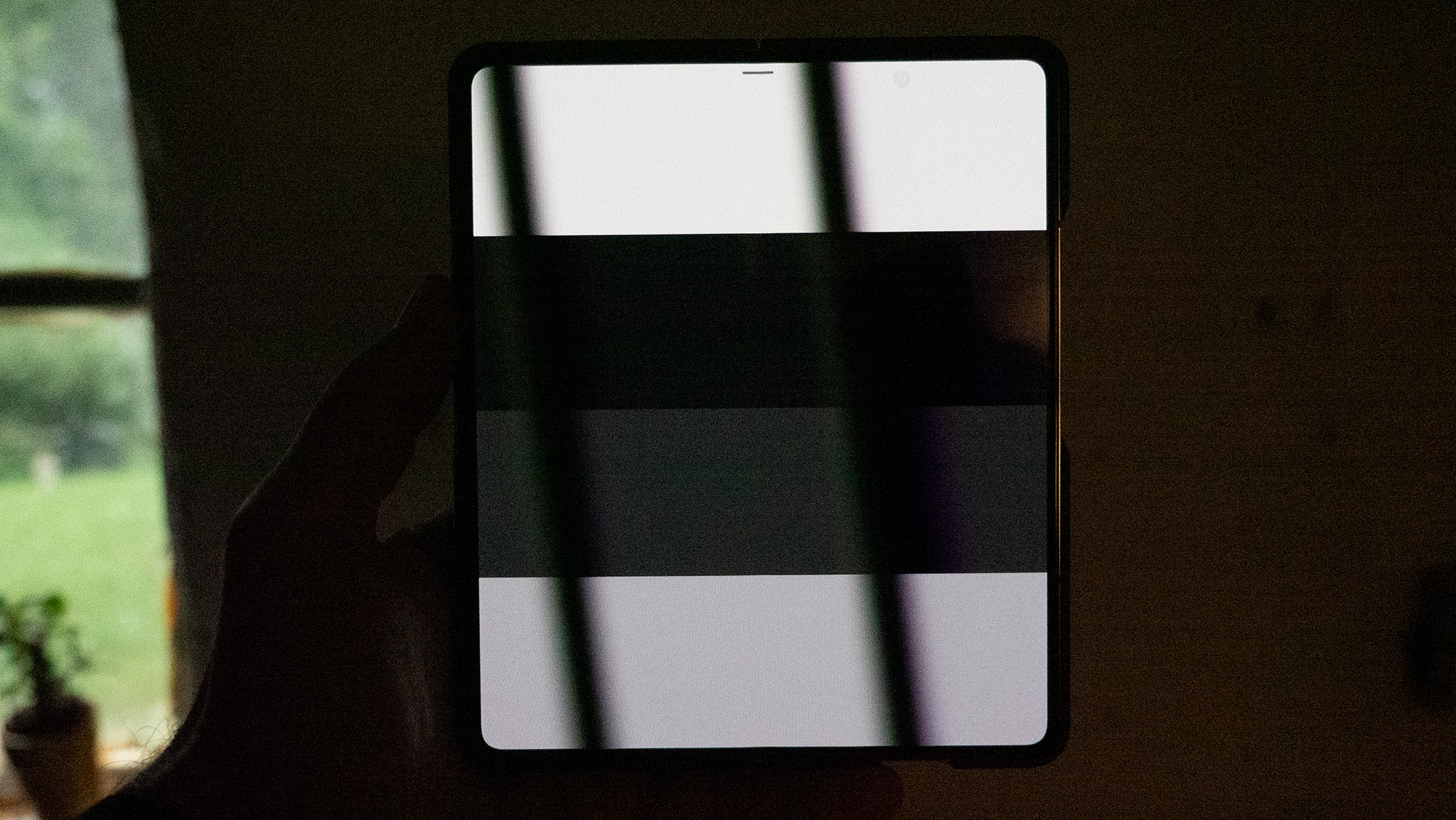
Don't believe me? Check out the images above, taken at a very slow shutter speed and high ISO to capture the PWM rate on each color. The black bars you see running from the top to the bottom of the display are how the camera sees the PWM rate. The thicker the bar, the more modulation occurs to create a color.
Notice that all of the light colors have a thinner black bar, and all the darker colors have a much thicker bar? Those pixels have to flicker a lot more to show that dark color because, when using PWM, the brightness of a pixel is controlled by the length of time the display is off during the pulsing cycle.
Notice the greyscale image, in particular, as those colors are the exact shades used in Android's dark theme across many manufacturers and apps.
Now, if we look at a phone that does proper DC dimming — the Motorola Edge Plus (2023) — you'll see that all colors are equally represented and have zero flicker difference visible between them. That includes darker greyscale images.
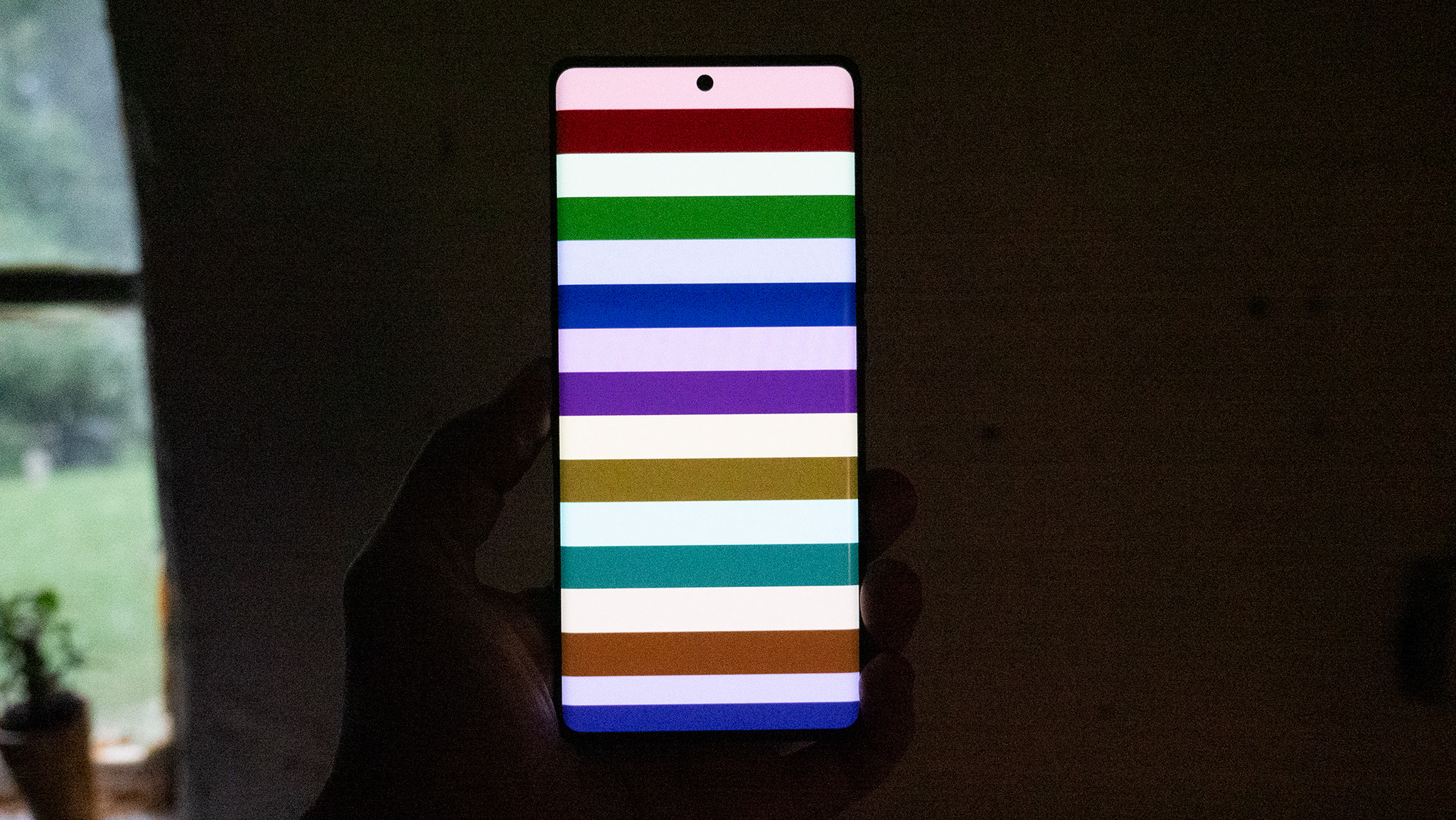
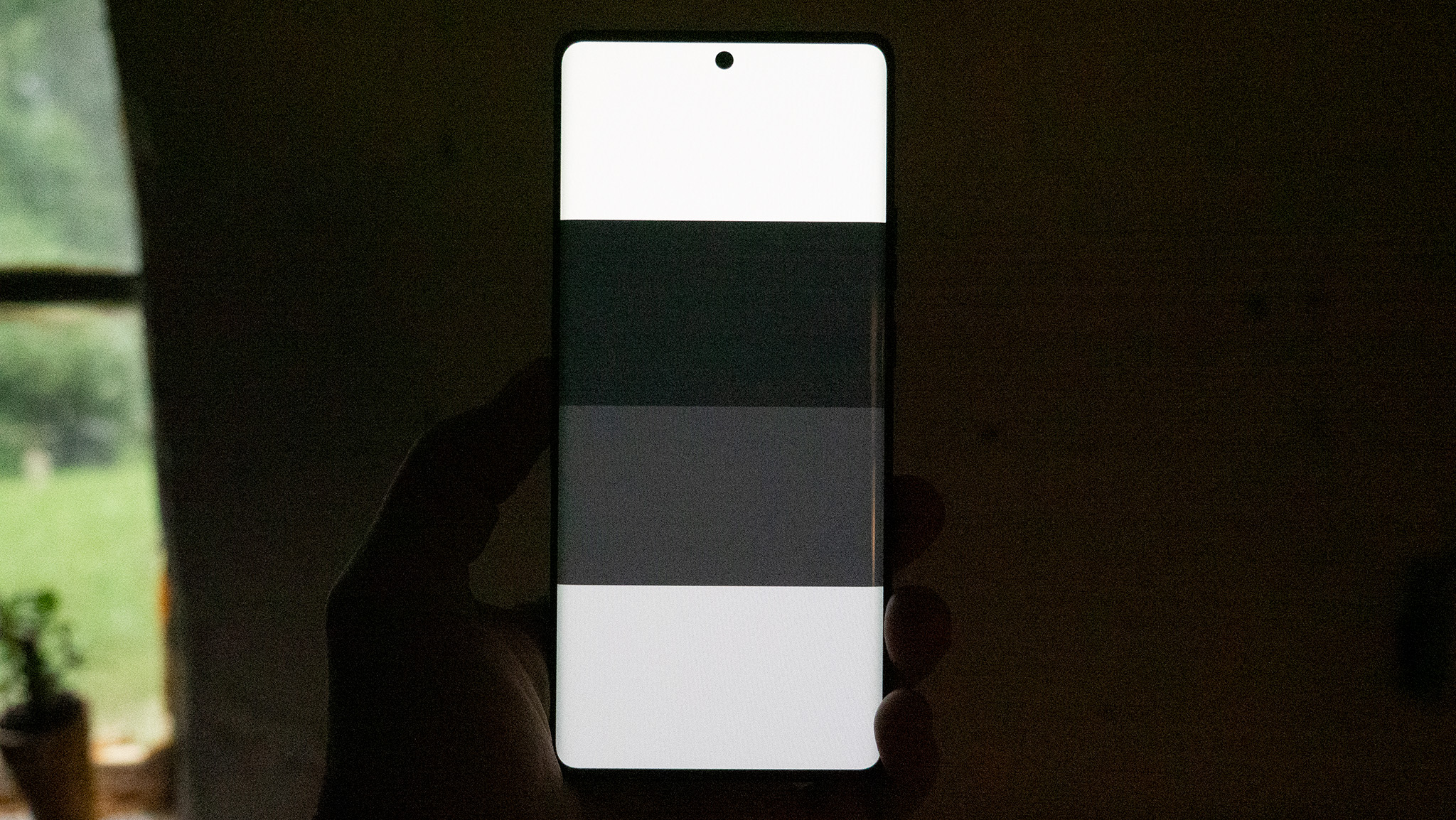
On phones that use PWM-dimmed OLED displays, use a light theme on your phone's UI and then cherry-pick apps that have settings for "lights out" mode. On apps like Twitter X, Lights Out mode makes the entire background black and only illuminates the display when other colors or text are present. That ensures that less of your display is awake to modulate on phones that use PWM dimming.
Lock the refresh rate
It might sound weird, but locking a phone's display refresh rate is sometimes easier on the eyes than a dynamic refresh rate on phones that use PWM dimming. There are a lot of theories as to why this is the case, but I personally think it's the variability of the refresh rate on LTPO OLED displays that's playing the biggest part.
Since the refresh rate changes constantly on these displays depending on what app you're using or what you're using the phone for — but the PWM rate likely remains constant — your eyes are constantly bombarded with varying levels of unnatural display refresh patterns.
Go into your phone's display settings and find the refresh rate option. Sometimes this is called "Smooth display" or something similar. Either turn it off or select a single refresh rate to test. Some phones allow you to select from several different rates to lock the display at.
Depending on the display type, choosing the lowest possible refresh rate of 60Hz might actually be the most comfortable. Give it a shot and see how you feel!
Get a better phone
The reality is that our definition of "the best phones" often revolves around processor speeds, camera quality, or other factors but often neglects how bad these phones' displays are for our eyes.
Thankfully, the best phones for PWM-sensitive people all offer great experiences, processing speeds, quality cameras, and, most importantly, displays that don't hurt to look at.

OnePlus has made huge strides toward a more eye-friendly phone and is the first phone Android Central has ever awarded 5 out of 5 stars. OnePlus gives you several eye-comfort options on a beautiful OLED display, plus top-notch hardware and years of software support.

You must confirm your public display name before commenting
Please logout and then login again, you will then be prompted to enter your display name.
